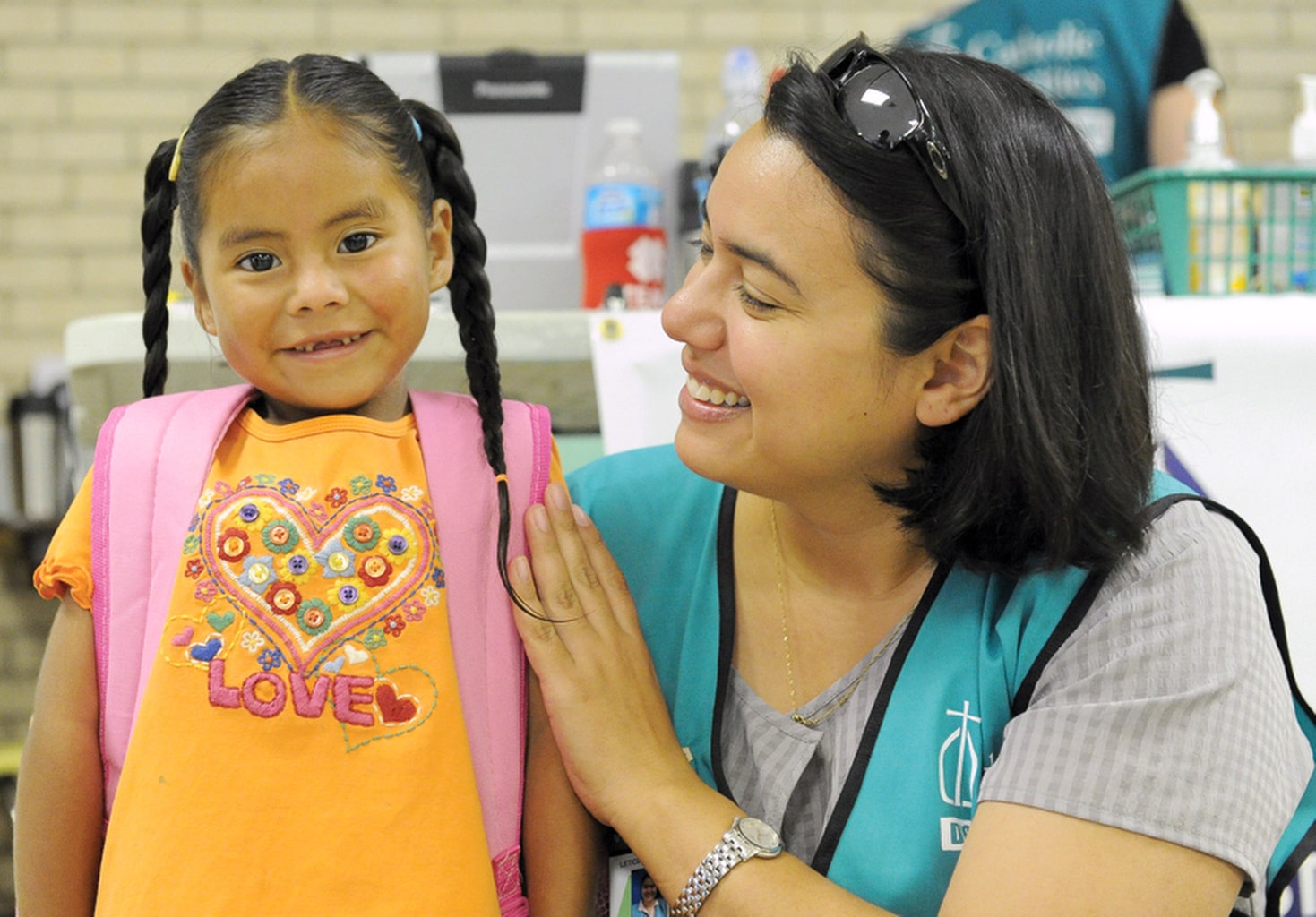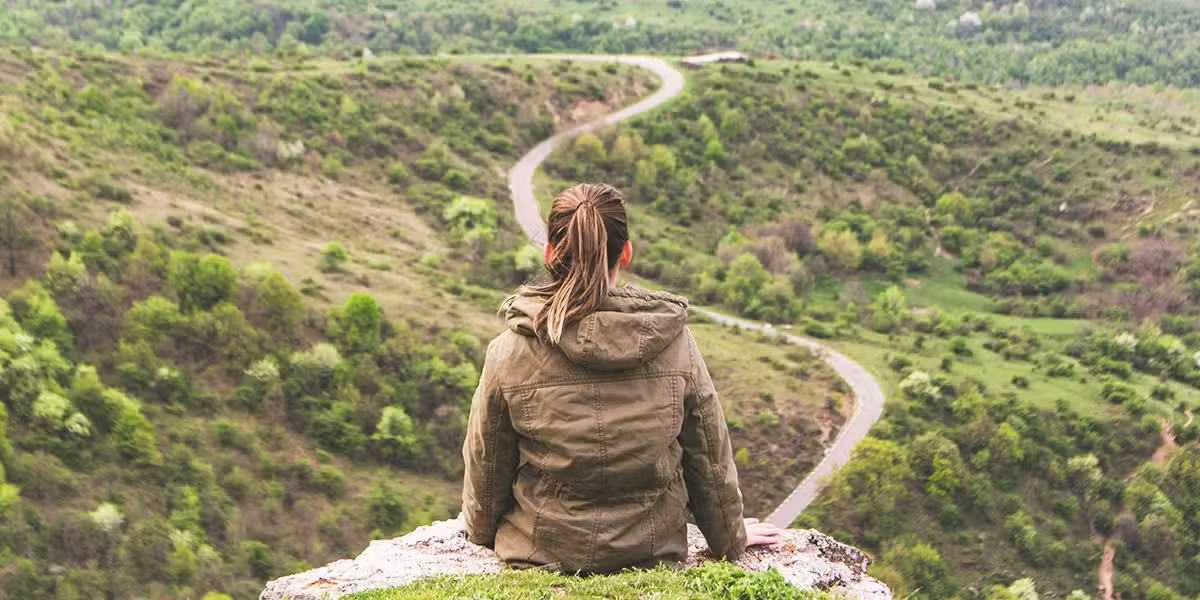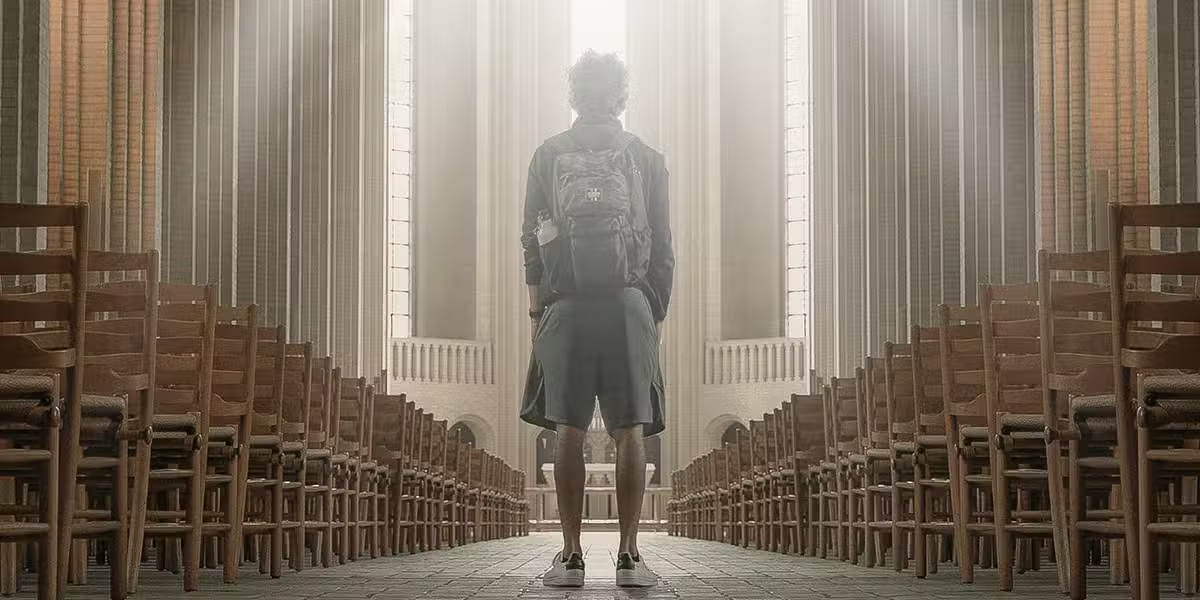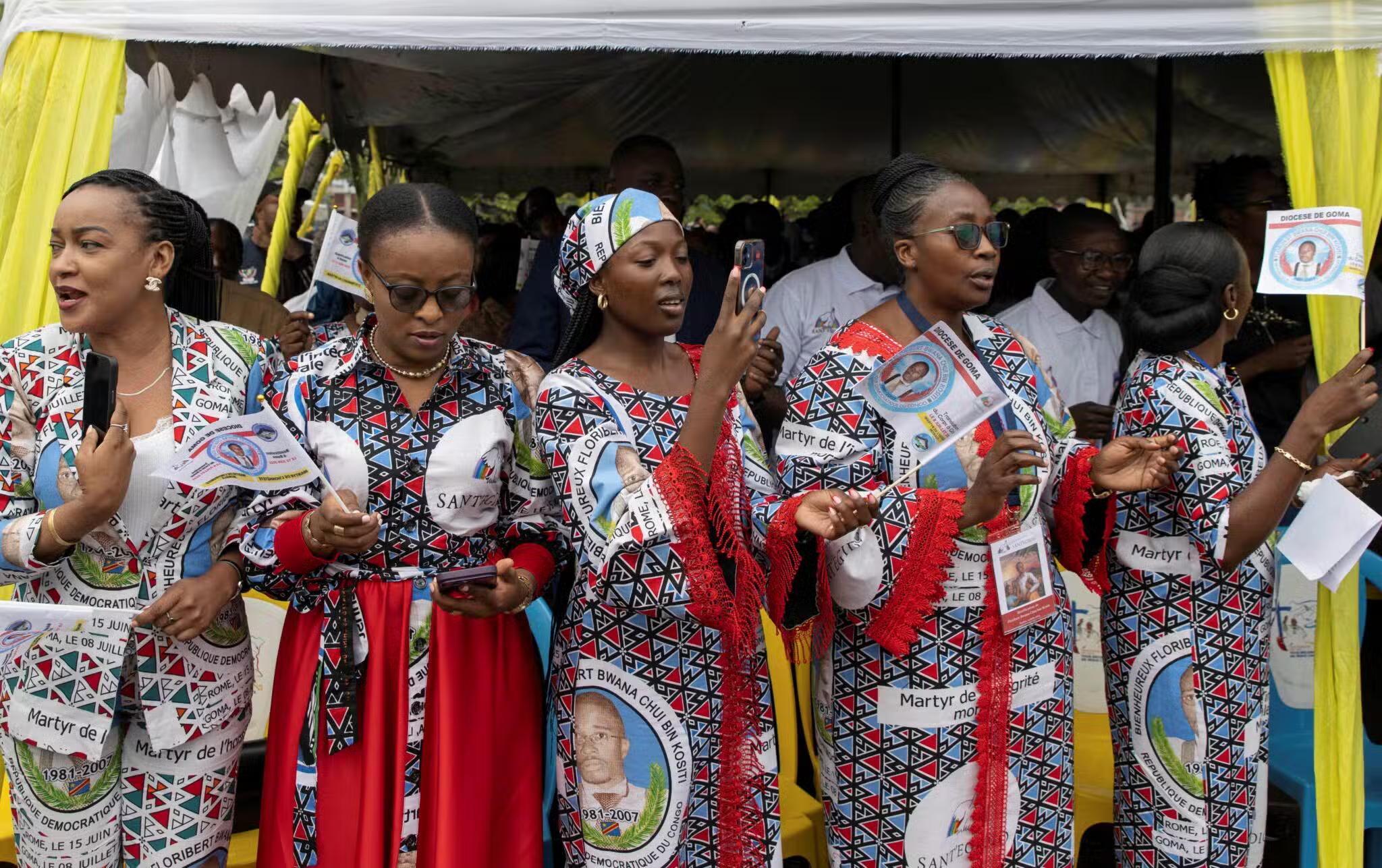The scene is repeated again and again as immigrants walk off a minibus and into the parish hall of a Franciscan church in McAllen, Texas. The moving gesture from greeters is a response to a modern-day exodus that began in Central America in 2014. Fleeing a future that held no hope, families began to move north in great numbers. And the place where many of them landed, after journeys that were long and dangerous, was Sacred Heart Parish.
Since June of that year, more than 30,000 undocumented immigrants, most of them women and children, have passed through this building, now called the Humanitarian Respite Center. McAllen, at the southern tip of Texas on the Rio Grande, has become ground zero for a crisis that no one saw coming. “What could we do? ” asks Pastor Tom Luczak, the friar who responded when the trickle of immigrants turned into a flood of biblical proportions. “This is what the Gospel says: ‘I was hungry and you gave me food.’ ” Here at Sacred Heart,
“The Gospel has become very real. ”
‘Positive Energy’
The Respite Center, next door to the rectory, offers just what the name implies: a bit of rest and relief. Outside, it’s reminiscent of M*A*S*H, with a bookmobile-sized shower unit parked next to a half-moon tent lined with cots. Inside the center are comfort stations surrounding dozens of racks and stacks of clothing. Folding tables with bins of baby supplies and hygiene essentials line the walls. A kiddie corral is every child’s dream, a cornucopia of pull toys, books, stuffed animals, trucks, and dolls. Alongside the kitchen is a row of dining tables draped in pink tablecloths and topped with sparkly centerpieces. All of it is coordinated by Catholic Charities of the Rio Grande Valley, manager of the facility since day one. Much of it is maintained bypeople like Alma Revesz, who lovesthe center and the people it serves.
“I think I am an addict to this, ” says Alma, who volunteered for months and now helps manage the facility. “It’s positive energy. It’s beautiful when the children hug you and say, ‘Thank you, lady, for what you do today.’ I feel Jesus hugging me. I can see his face in all these people. ”
Father Tom often stops by to meet the families. “I try to come and ask all of them who they are, where they’re going, ” he says. And when they leave, “I like to say good-bye. ” Today he’s playing peek-a-boo with a toddler who ducks behind his laughing mama. After a brief exchange in Spanish, Father Tom announces, “His name is Anthony. They’re headed to Virginia, ” where relatives will give them shelter.
Another immigrant sits next to an electrical outlet, a cuff around his ankle plugged into the wall. Whatever their reason for coming, “All of them are here illegally, ” Father Tom says. Ankle bracelets allow authorities to track the arrivals when they leave, until they appear in court for a hearing on their status. Charging the device takes three hours a day difficult for most, impossible for some. “It’s sad to see. The people come and they finally feel safe, and now they’re being clamped with ankle bracelets like criminals. ”
Fleeing Violence
Their story has been beamed around the world by National Geographic, Chinese media, and the BBC. Father Tom remembers the phone call that started it all. In June 2014, he and three other friars who share the care of two local parishes were in Chicago for the chapter of their province, Assumption of the Blessed Virgin Mary. On the phone was Sister Norma Pimentel, a member of the Missionaries of Jesus and executive director of Catholic Charities ofthe Rio Grande Valley.
She asked, “Father Tom, can I borrow your parish hall for a couple of days? ” and explained the problem a surge in the number of immigrants crossing the border at Reynosa, Mexico, where the Rio Grande narrows.
In the beginning, Sister Norma says, “There were a great number of children coming ” by themselves. “The Border Patrol and Department of Refugee Resettlement were not prepared to handle it. They started creating a lot of facilities for unaccompanied children. ”
Families were another matter. “The Border Patrol was packed with a thousand people at their processing facility and were only equipped to handle 300, ” Sister Norma says. To ease overcrowding, many were issued temporary papers and released “provisionally ” pending a hearing. Confused and exhausted, they were left at the bus station to fend for themselves. Those from Guatemala spoke indigenous languages that no one understood.
Good Samaritans brought them food and water. Catholic Charities stepped in, suggesting that a way station would help them get their bearings. A couple of blocks from the bus station, the parish hall at Sacred Heart was the perfect spot. “I had no idea how long this would be, ” Sister Norma says. But Father Tom told her, “Sister, you stay here until this ends. ”
As Sister Norma learned, the families sold everything, risked everything to escape extortion and brutality from gangs and drug cartels in Honduras, Guatemala, and El Salvador. Children were being kidnapped for gang recruitment, slave labor, the sex trade, and, most terrifying of all, harvesting of their organs for transplants. “There is more money in selling children than in trafficking, ” Sister Norma says. One parent was threatened: “If you don’t give us your child, I will kill him in 15 days. ”
Pulling Together
Taking only the clothes on their backs, they hired coyotes (smugglers) to get them here on foot, by bus, in the backs of big rigs, on top of trains. “A great number are lost in Mexico, ” according to Sister Norma. “Many people die without anyone knowing. ”
For Father Tom, “The saddest thing is people who get separated from their families ” along the way. “Husbands have been killed. There have been many pregnant ladies. Babies have been born here. It must be so bad [where they came from], it’s worth taking the risk. ”
The first guests were welcomed to the Respite Center on June 10, 2014. “There were 200 a day when it first started, ” Father Tom says. “It was unorganized; nobody knew what was happening. Nobody knew the magnitude ” of the problem. A former provincial minister, Father Tom is no stranger to crisis, but the first summer was “unbelievable. ”
Initially, “It was 24 hours a day, ” says Franciscan Brother Andre LeMay, part of the parish team at Sacred Heart. “I said I couldn’t keep this up. People from all over the world were inundating the center. ” Press briefings were held to accommodate national and international media. But in the midst of chaos, something miraculous happened.
Volunteers showed up from every corner of Hidalgo County and beyond. Doctors and nurses donated time to treat minor injuries and examine expectant mothers. High schools and colleges sent students to help. Jews, Muslims, and Protestants pitched in. “The project has been supported by every religion in town, ” Father Tom says. “It’s a wonderful example of how people of different faiths can work together. ” The Salvation Army made chicken soup and they’re still doing it. The City of McAllen offered transportation to and from buses and gave Sacred Heart free parking and venues for the meetings, parties, and Quinceaera celebrations that were moved from the parish hall.
Since that summer, the media spotlight has shifted, but the immigrants keep coming not only from Central America, but from Brazil, Cuba, Africa, India, and the Ukraine. The surge has slowed to 20-25 newcomers daily, but the Respite Center is apparently here to stay.
“We’re looking at the possibility of building a parish hall for Sacred Heart ” to replace the one they lost, says Sister Norma. “They set aside a vital part of the parish community for us so we can serve the many immigrants. We have looked at plans for developing a new hall. It’s a lot of money, and I’m hoping the community and others can help. ”
Meanwhile, it’s business as usual at the Respite Center.
Pilgrims and Strangers
There’s usually a wave of arrivals in the morning. At times, a volunteer says, “We don’t know how many are coming until they show up. ” With center director Eli Fernandez on vacation and a couple of regulars fighting strep throat, two newcomers are learning the ropes. “Be sure to stay with the family throughout the process, ” their guide tells them. “This afternoon we have 75 coming in so we really need help. ¡Ay, ay, ay! ”
Two blocks away at the bus station a Sacred Heart parishioner meets a group dropped off by immigration and customs enforcement. Dispirited, disoriented, the group moves in slow motion, as though roused from sleep.
A toddler too tired to stand hangs on to the belt of a mother holding a plastic bag in one hand and a manila envelope in the other. Nothing not the ride, not the commotion could wake the exhausted babies draped over shoulders. The parishioner asks if they would like to eat and take a shower. One traveler responds, “Oh, thank God! ”
They enter the Respite Center to cheers and applause, and are directed to folding chairs for an orientation from Sister Norma. She tells them in Spanish: “We’re gonna give you clothes. The volunteers are giving you their time just because they love you. ”
It takes people anywhere from two to eight weeks to travel from Central America to McAllen. For some, the journeys are horrific, ending in a stay of two or three days in a border detention facility. Recent arrivals describe the climate there as “an icebox. ”
After the families are registered, volunteers lead them around the room, stopping at a table where Sylvia Cardenas folds diapers and dispenses baby essentials. “I’m an old registered nurse, ” says Sylvia, a regular since the beginning. “I like helping people because that’s what nurses do. ”
Next to her, Amy McCoy assembles travel packs combs, toothbrushes, toothpaste, and deodorant for the journeys to come. “Oh, yes, this is what I want, ” a guest tells her in Spanish. “I get to feel human again. ” Amy, a Baptist from central Texas, moved here after a mission trip. “A guy from my home church is from Guatemala. He said, ‘You don’t know what this means to the people you’re helping.’ This cemented that I’m where I’m supposed to be. ”
Refreshed, Renewed
As families dine on chicken soup a light meal is all they can handle volunteers move among the racks, collecting shirts, shoes, and pants in the sizes required. Immigrants will leave their well-worn clothing behind. “There’s a magical moment when they get a shower and clean clothes, ” Father Tom says. “Their whole disposition changes. ”
Revived by food, children systematically work their way through each box of toys, many leaving with a stuffed animal they can hug or use as a pillow on the next leg of their journey. From arrival to departure, there’s a marked difference in demeanor.
“With this little bit of time you change their minds, how they see the future, ” says Alma. “They are [stronger], a lot of them told me. A lady at the bus station said, ‘Thank you. I was feeling dead. I have my life again.’ ”
Alma dons a hairnet in the kitchen to assemble 24 bags of cheese sandwiches road food for those departing tonight. Sending them off to an uncertain future, “I pray and ask God to take care of them because there is nothing else I can do. ”
In time they may forget the pain of the past. But they will always remember a parish hall where they were treated like family.








